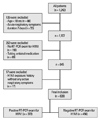Abstract
Purpose
Materials and Methods
Results
Conclusion
Figures and Tables
 | Fig. 1Study diagram for influenza A (H1N1) clinical criteria comparisons and suggestions. Clinical and laboratory evaluations were analyzed from all patients who were admitted to the flu center at Severance Hospital. The study period was from November 11 to December 5, 2009. Acute respiratory symptoms were defined as self-reported influenza-like symptoms including chills/feverishness, cough, sore throat, headache, rhinorrhea, and/or myalgia, with or without a documented fever. RT-PCR, reverse transcriptase-polymerase chain reaction. |
 | Fig. 2Clinical symptoms and signs of influenza A (H1N1)-positive cases and influenza A (H1N1)-negative cases. Influenza A (H1N1)-positive was defined as a positive result on real-time RT-PCR. Conversely, a negative result on RT-PCR was defined as influenza A (H1N1)-negative. Cough, myalgia, fever (greater than 37.8℃ or antipyretic use), and rhinorrhea are more frequent in the influenza A (H1N1)-positive group. *p < 0.05, calculated by the χ2-test and Fisher exact test (for categorical variables). RT-PCR, reverse transcriptase-polymerase chain reaction. |
Table 1

An alcohol drinker was defined as a person with current alcohol intake more than once a week and a smoker was defined as a current cigarette smoker. Regular exercise was defined as exercise or physical work for more than 30 minutes three times a week.
RT-PCR, reverse transcriptase-polymerase chain reaction.
*Influenza A (H1N1)-positive was defined by a positive result on real-time RT-PCR. Conversely, a negative result on RT-PCR was defined as influenza A (H1N1)-negative. p values between influenza A (H1N1)-positive and negative were calculated with the t-test, Wilcoxon's rank sum test (for continuous variables) or χ2-test, and Fisher exact test (for categorical variables).
†Underlying conditions: asthma, chronic pulmonary disease, coronary heart disease, Hypertension, Diabetes Mellitus, thyroid disease, chronic renal failure, cancer, immune deficiency disease, cerebrovascular disease, chronic liver disease or pregnancy.
Table 2

Table 3

Table 4

The CDC criteria are the presence of fever (> 37.8℃ or previous medication with antipyretics) plus one or more of the following: rhinorrhea, nasal congestion, sore throat, or cough. The WHO criteria are the sudden onset of fever (> 38℃) and cough or sore throat. The ILI criteria are the presence of fever (≥ 37.8℃) plus two of the following four symptoms: cough, sore throat, myalgia, and headache. Our suggested criteria are the presence of cough plus fever or myalgia.
OR, odds ratio; CI, confidence interval; PPV, positive predictive value; NPV, negative predictive value; AUC, area under the curve; ILI, influenza like illness.
*Age, sex adjusted OR, AUC.




 PDF
PDF ePub
ePub Citation
Citation Print
Print


 XML Download
XML Download